This post originally appeared on Murder Is Everywhere.
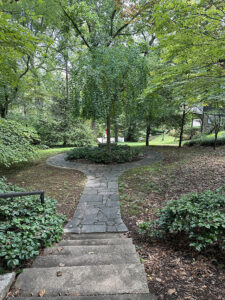
My summer started out with grand plans: cross country travel for a book tour, and a chance to catch up with family and friends in the Midwest and West. But life throws you curveballs, doesn’t it? And my shocker was a big fat COVID-19 infection that occurred when I flew out of California back to the East. The result has been a blessedly mild, but long-lasting illness.
In third week of quarantine, I spend most of my time on my Victorian home’s two sleeping porches—an architectural feature created as a response to the era’s contagious, often lethal, epidemics. I’m grateful that none of the successive homeowners thought to remove these outdoor havens, where I to eat my meals, read books, work on my writing, and log onto PBS to watch Grantchester. But not all the time. The soft focus of nature distracts me toward something better: the young squirrels chasing each other up and down the trees. After I’ve watched them while having morning coffee, I slip downstairs and out to the garden to do some weeding.
My attempts to bring my renegade rudbeckia into order remind me of the magical time I had exploring gardens this spring and summer with friends. These green spaces still hold a place in my mind that stands for freedom, imagination, creativity and health.
One of my favorite places to wander is Mt. Cuba, a historic estate in Delaware owned by a late DuPont heiress and her family and now turned over to a trust. The goal of Mt. Cuba is the development of attractive and sturdy cultivars of local native plants—and sharing with visitors ways to design beautifully with natives. Here’s a glimpse of how the native can be elegantly landscaped along a curved walkway.
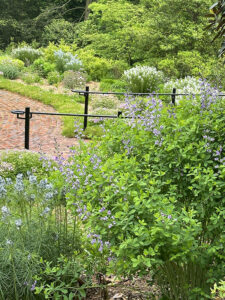
While visiting Minnesota in both spring and summer, I rambled around Lake of the Isles, which sits between Kenwood and Lowry Hill and Uptown neighborhoods. The path around the lake is just over three miles, completely flat and with separate trails for walkers and bicyclists. The surrounding parkland once was landscaped with the fashionable imported plants of the era; roses and the like. In this century, native plants have slowly grown and stabilized. The water might be cold, but Lake of the Isles is the beating, warm heart of my memories of life a decade ago in Minneapolis.
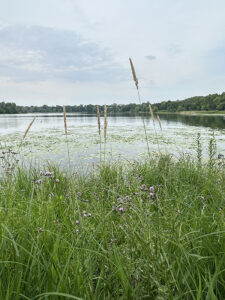
The Golden State has its own weather zones that have been going haywire in recent years. During my July visit, Southern California was blisteringly hot, and San Francisco was uncharacteristically sunny and pleasant (though its residents still wore down jackets, expecting the usual). My friend Sue drove me to across the East Bay to visit Filoli, a foundation-owned garden and historic house in Woodside. The name was made up to represent these ideas: Fight, Live, Love. Rather intense; could it have been inspired by Great War?
The grand Italianate mansion was designed by the architect Willis K. Polk, starting in 1915, for William and Agnes Bourn. Mrs. Bourn hired a female floral expert to install their gardens–a growing trend in the era of famous professional and private gardeners like Edith Wharton, Gertrude Jekyll, Elizabeth von Arnim and Vita Sackville-West. Bella Worn, who came from an elite local family who’d lost their fortune, had both an instinctive understanding of flowers, and significant experience owning at a floral business with her two sisters. As a garden designer, Bella was reputed to have the toughness and confidence to get her way on plant decisions every time. Bella spent most of the 1920s driving out to Filoli in a chauffeured car once a week, instructing every planting and pruning on the property, and then socializing with the elite in the evening. I picture her as the perfect heroine for a traditional mystery series set amongst the robber barons of California.

In the Roaring Twenties, twelve gardeners reported to Bella Worn. Today, fourteen horticulturists maintain the grounds for visitors’ pleasure. Filoli’s gardens are laid out in a series of outdoor rooms, a popular design for landed gentry in the early 20th century. As Sue and I explored the many paths, I found myself exclaiming about the gorgeous surprises appearing with each turn we took. Soft drifts of color rolled in waves, creating vistas both abundant and soothing.

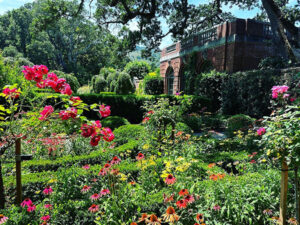
Temperatures were in the high 80s during our visit to Filoli. Despite the heat, I noted elegant frocks and the crisp suiting worn by many visitors. These glamorous young people set out elaborate picnics and posed against the vivid floral backdrops. Truly, the only missing element was a tuxedoed waiter carrying champagne cocktails—and perhaps shrimp cocktail on ice. How quickly I had lost my grasp on reality!
And that is the value of historic gardens.
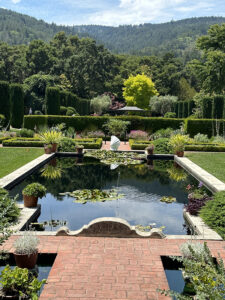

Bonjour, Je viens de découvrir vos livres. J’ai terminé “Les Veuves de Malabar Hill” J’ai été très vite attachée à ce personnage de Perveen, et j’ai recherché à en savoir plus sur l’auteur. Me voici donc sur votre page. J’espère que vous allez très vite guérir et que ce virus ne vous empêchera pas de nous écrire de nouvelles histoires, si proche de l’histoire de ce pays passionnant ! Merci. Tous mes voeux.